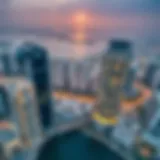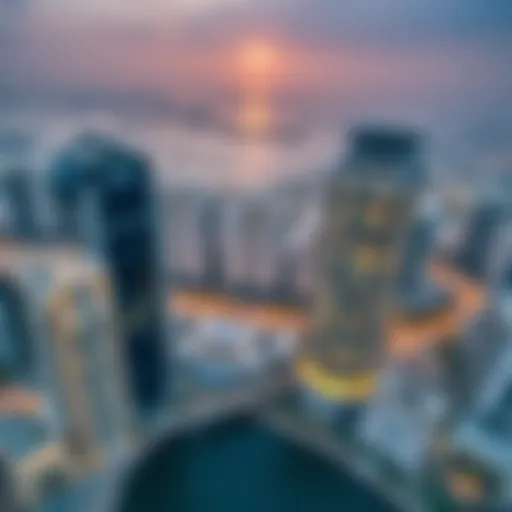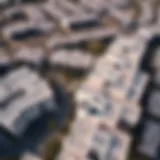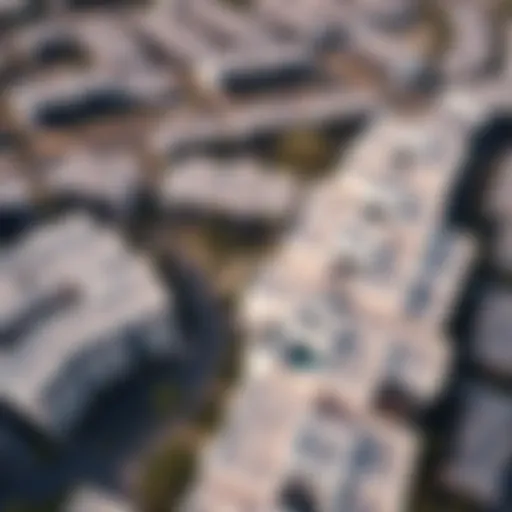Discovering Salah Al-Din Street: Dubai's Real Estate Gem


Intro
As one navigates through the bustling milieu of Dubai, Salah Al-Din Street stands out as a vital artery in the city's ever-evolving real estate landscape. This thoroughfare has experienced significant transformations over the years, representing a microcosm of Dubai's rapid growth and development. Known for its blend of historical influences and modern architecture, Salah Al-Din Street captivates both investors and homebuyers alike. To appreciate its role in the property market, it’s crucial to explore the surrounding amenities and the myriad of opportunities available.
The street isn't just about properties; it encapsulates a lifestyle that draws a wide array of stakeholders in the real estate sector. From families searching for their perfect homes to investors eyeing lucrative deals, the appeal of Salah Al-Din Street is broad and profound. Setting foot on this road, one can almost feel the pulse of the city's dynamic real estate market.
In this article, we will delve into the current market trends shaping this area, present investment opportunities ripe for consideration, and highlight the unique characteristics that make Salah Al-Din Street not just a location, but a coveted address in Dubai's property narrative. The following sections aim to illustrate why understanding this corridor is essential for anyone serious about the Dubai real estate scene.
Prelude to Salah Al-Din Street
Salah Al-Din Street plays a pivotal role in Dubai’s real estate landscape, serving as a vital artery that connects various districts and influences property values across the region. Its strategic location, flanked by significant landmarks and neighborhoods, makes it a particularly attractive area for both investors and homebuyers. As urban development accelerates in Dubai, the street stands as a testament to the city’s growth and a mirror reflecting the dynamics of its real estate market.
Geographical Significance
Salah Al-Din Street stretches through the heart of Dubai, acting as a conduit that links important areas such as Deira, the traditional trading center, to some of the more contemporary districts of the city. Its accessibility to main roads and thoroughfares not only enhances daily commutes but also increases its appeal to businesses looking for prime locations.
What sets it apart is its proximity to the Dubai Metro stations, making it an ideal spot for those relying on public transport. This aspect is particularly significant in a bustling metropolis where traffic congestion can be a daily challenge. For residents, easy access to various amenities adds to the overall convenience and desirability of the area.
Historical Context
Historically, Salah Al-Din Street has been more than just a physical space; it encapsulates a rich narrative of Dubai's transformation from a modest trading port to a bustling global city. Many of the buildings lining the street have stories to tell, reflecting the blend of old and new architecture. In the mid-20th century, this area was teeming with small businesses and local markets, catering to a diverse population.
As Dubai embarked on its ambitious developmental agendas in the late 20th century, Salah Al-Din evolved accordingly. New commercial and residential projects have emerged, meeting the increasing demand for modern amenities while still retaining a hint of its historical charm. This evolving landscape provides a unique perspective on how heritage and modernity coexist within the urban fabric of Dubai.
Current Market Overview
Today, Salah Al-Din Street is experiencing a revamp as part of Dubai’s broader efforts to enhance its urban areas. The real estate market here is gradually shifting, characterized by a mix of high-rise residential projects, low-rise apartments, and commercial spaces.
Recent trends indicate a steady rise in property values, driven by the influx of expatriates and the growing appeal of the area’s amenities. Reports show that rental prices have increased noticeably in the past year, appealing to a range of tenants—from young professionals to families seeking a community feel without straying too far from the city’s pulse.
Key Highlights:
- Diverse property types available, catering to various market segments.
- Continued interest from investors looking to capitalize on future growth.
- Infrastructure improvements contributing to rising property values.
Salah Al-Din Street stands not just as a street but as a vibrant microcosm of Dubai's real estate potential. Investors and homebuyers alike are recognizing its transformative journey and abundant possibilities as they consider integrating this corridor into their portfolios.
Real Estate Market Trends in Salah Al-Din
Understanding the real estate market trends along Salah Al-Din Street is crucial for anyone looking to dive into Dubai's property scene. This corridor has seen significant changes over the years, reflecting the dynamic nature of the region's market. It offers a mix of residential and commercial spaces, making it attractive to various investors.
Property Types Available
Salah Al-Din Street is a melting pot of property types, catering to a wide range of preferences and budgets. Here's a snapshot:
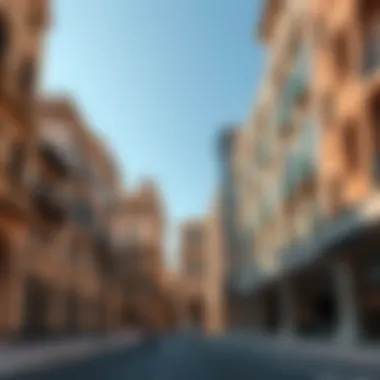

- Residential Buildings: Apartments dominate the residential space, ranging from cozy studios to spacious three-bedroom units. Many buildings come equipped with modern amenities, which adds to their appeal among expatriates and locals alike.
- Commercial Spaces: The street also features a selection of retail shops, offices, and showrooms. Local businesses often thrive here, supported by foot traffic and the adjacent neighborhoods.
- Mixed-Use Developments: Some of the newer complexes combine residential and commercial offerings, creating live-work-play environments that adapt to contemporary living demands.
This diversity in property types enhances the attractiveness of Salah Al-Din Street to a broad audience, promoting a thriving community.
Price Fluctuations
Price trends on Salah Al-Din Street are not set in stone; they often reflect the larger economic environment and regional demand. Over the past few years, the average rental prices in this area have experienced fluctuations influenced by:
- Market Demand: As more people flock to Dubai, interest in properties on Salah Al-Din Street has surged. This spike can lead to increased rental costs, particularly in sought-after buildings.
- Economic Factors: Global economic conditions can impact property prices. Economic downturns may lead to a dip in prices, while recoveries often result in an upward trajectory.
- Development Initiatives: Infrastructure developments and urban upgrades can positively influence prices, making certain areas within Salah Al-Din more desirable over time.
Keeping an eye on these fluctuations can provide valuable insights for potential buyers and real estate agents attempting to navigate these waters.
Investment Hotspots
When scouting for investment opportunities, Salah Al-Din Street offers several hotspots worth considering:
- Near Metro Stations: Properties located close to the Dubai Metro stations tend to attract higher interest. Investors can benefit from potential price increases in these areas as accessibility improves.
- Upcoming Projects: Knowledge of upcoming developments in the vicinity can also inform investment decisions. For instance, reports suggest that certain plots along the street are being eyed for future mixed-use projects.
- High Foot Traffic Zones: Areas with heavy foot traffic, especially near commercial establishments, are ripe for investment. These sections guarantee visibility, resulting in both higher rental yields and solid resale values.
Investors looking at Salah Al-Din Street can find numerous options tailored to their goals, whether they aim for high turnover rental properties or long-term developments.
Accessibility and Transport Links
Accessibility is a pivotal element in any real estate landscape, and Salah Al-Din Street is no exception. This busy thoroughfare is not just a passage; it serves as a vital artery connecting different parts of Dubai, thereby shaping both residential and commercial real estate. Investors and buyers alike recognize that accessibility can significantly influence property value. A well-connected area tends to attract more businesses and residents, driving up demand.
Recent developments in transport infrastructure have enhanced the appeal of Salah Al-Din Street. With the continuous growth in population and urbanization, efficient transport links have become paramount. These links facilitate ease of movement for residents and visitors and contribute to the local economy by making it easier for consumers to access services and businesses in the area.
Public Transportation Options
Public transport on Salah Al-Din Street is both diverse and robust, catering to the needs of commuters from all walks of life. The street is serviced by several bus routes, linking residents to key destinations throughout Dubai. Notably, the Dubai Metro is within easy reach, providing an efficient alternative for those traveling to the city center or to other districts. The accessibility of these transport options means that most daily commute needs can be met without the hassle of driving or hunting for parking.
- RTA Buses: Regular bus services operate along the street, making it easy to hop on and off at various stops.
- Dubai Metro Stations: The nearest metro stations, such as Al Rigga and Union, are just a short walk away, offering seamless integration with the metro network.
- Taxi Services: Reliable taxi services are readily available, further emphasizing the convenience of transportation.
These options ensure that residents can move around the city with minimal delays, reducing any potential stress associated with daily commuting.
Road Network and Connectivity
The road infrastructure surrounding Salah Al-Din Street plays a crucial role in its desirability. Major roads like Al Ittihad Road and Rigga Road facilitate quick access to surrounding neighborhoods and commercial hubs. The network allows for smooth traffic flow, which is essential, especially during peak hours.
- Multilane Roads: The roads are designed to handle substantial volumes of traffic, minimizing congestion.
- Easy Access to Major Highways: Connections to Sheikh Zayed Road and other major highways make it easier for residents and businesses to reach key areas in Dubai.
- Proximity to Hubs: The road network ensures that Salah Al-Din is conveniently located near commercial centers and recreational areas.
In summary, the accessibility and transport options available on Salah Al-Din Street are instrumental in shaping the locale's real estate landscape. Potential buyers and investors view these factors as critical indicators of long-term value and livability in the area.
"Efficient transport links can turn a good location into a great one, often boosting property values significantly."
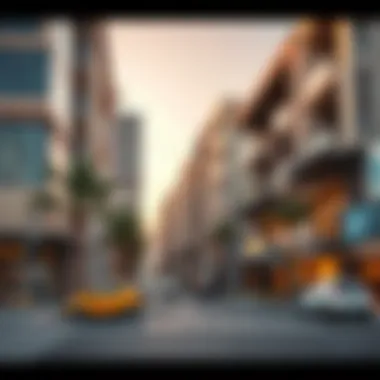
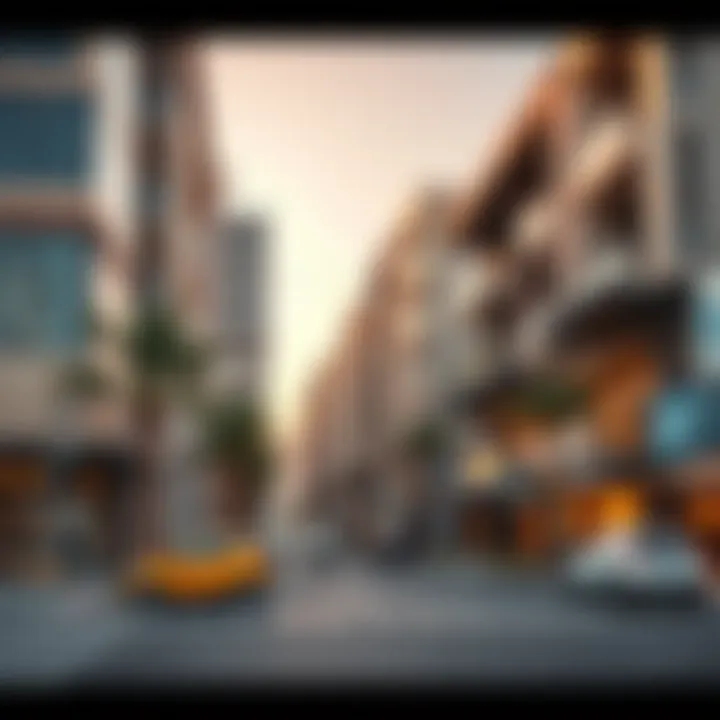
For further reading, you may explore resources such as RTA for details about public transport in Dubai and Dubai Statistics Center for demographic insights.
Local Amenities and Lifestyle
Salah Al-Din Street is not simply a thoroughfare; it’s woven into the fabric of Dubai’s lifestyle. The local amenities and lifestyle options available along this corridor play a crucial role in attracting both investors and residents. People seek more than just a place to live; they’re after a community that supports their daily needs and enhances their quality of life.
Shopping and Dining
The shopping scene along Salah Al-Din Street is nothing short of vibrant. This area boasts a kaleidoscope of retail experiences ranging from traditional souks, like the Naif Souk, where local culture meets commerce, to modern shopping centers such as Al Ghurair Centre. Here, you can find everything from the latest fashion trends to unique handicrafts.
Dining options are equally diverse, catering to a broad range of tastes and preferences. Food lovers can indulge in a culinary journey that spans various cultures. Whether it’s a bustling cafe serving Arabic coffee or a family-run restaurant offering traditional Emirati dishes, the choices are plentiful. The street also houses international chain restaurants, ensuring that familiar flavors are never too far away.
Challenges in the Real Estate Market
Navigating the real estate waters on Salah Al-Din Street isn't as simple as securing a property and settling in. Investors, buyers, and real estate agents all need to be aware of several challenges that can make the journey a bit rocky. Understanding these challenges is crucial for anyone looking to carve out a niche in this burgeoning locale.
Regulatory Issues
Ah, the never-ending labyrinth of regulations! In Dubai's ever-evolving real estate sector, the regulatory framework can feel as complex as a labyrinthine bazaar. One key issue involves the shifting laws that govern ownership rights, especially for foreign investors. The Government of Dubai has implemented initiatives to entice international buyers, such as offering freehold properties in specific areas. However, changes in legislation can happen quickly, and what might be true one day could be outdated the next. It’s vital for stakeholders to stay informed about current regulations to ensure compliance.
- Key Regulations to Watch:
- Freehold and leasehold properties
- Changes in property taxes
- Zoning laws affecting property types
Staying attuned to local legal updates and anticipating future changes can save a potential buyer from big headaches down the line.
Market Saturation
When it comes to supply and demand, Salah Al-Din Street is at a precarious point. The excitement around new developments has led to a surge in construction, resulting in a market that's perhaps more saturated than it should be.
As a consequence, property values can get a bit wobbly, leaving many investors wondering if they made the right choice. With several new buildings coming up or recently completed, the once hot market risks cooling down.
Some points to consider include:
- Current Inventory Levels: High availability can drive prices down.
- Age of Properties: Newer units may overshadow older ones, affecting their rental potential.
- Risks of Overbuilding: Developers may find themselves in a competitive race with little room to maneuver.
Economic Factors Impacting Prices
In the end, external economic factors will play a significant role in shaping the real estate landscape on Salah Al-Din Street. Changes in global oil prices, economic diversification efforts in the UAE, and even geopolitical considerations can alter the trajectory of property values.
It's worth looking at:
- Interest Rates: Fluctuating rates can change the affordability of properties for buyers.
- Inflation Trends: Rising inflation rates can squeeze household budgets, making investments less appealing.
- Economic Growth: A robust economy often leads to increased demand for property, while slow growth can have the opposite effect.
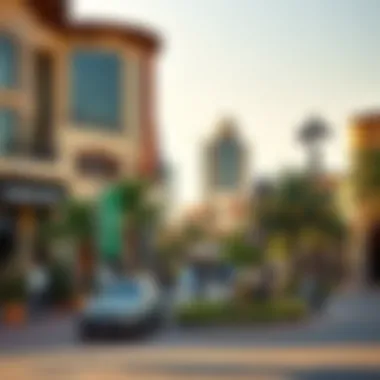
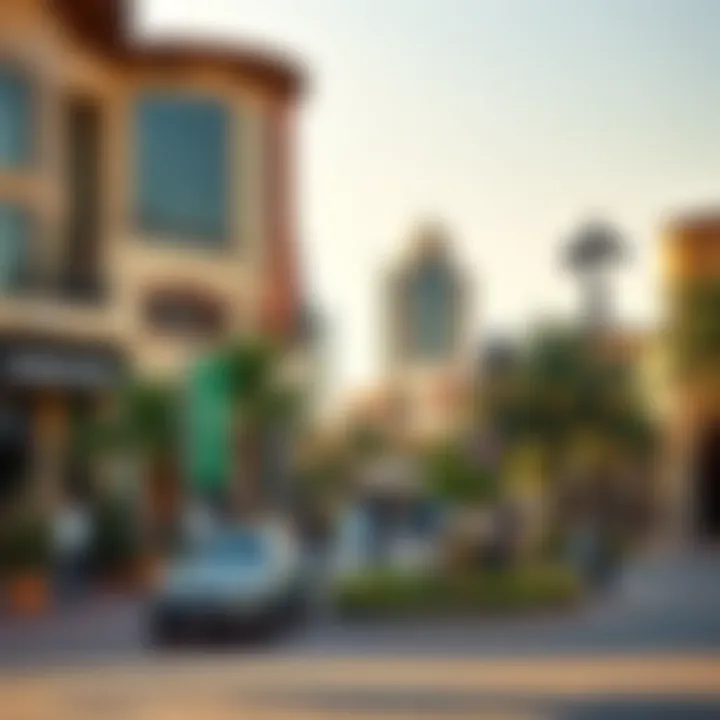
Understanding these economic nuances is crucial for making informed decisions. Investors willing to scrutinize these elements can better position themselves for success, while those who overlook them might find themselves in a tight spot.
"In real estate, knowledge is power; every shift in regulations or market demand can be the difference between a savvy investment and a costly blunder."
By comprehensively addressing these challenges, potential buyers and investors can arm themselves with the information necessary to navigate the intricate world of Salah Al-Din Street real estate.
Future Outlook for Salah Al-Din Street
The future of Salah Al-Din Street appears promising, and for those taking a serious look at Dubai’s real estate scene, this area is emerging as a focal point. The street is not just a thoroughfare; it represents a strategic investment path influenced by ongoing urban development, shifting market dynamics, and growth projections that are hard to ignore. As the demand for residential and commercial investments rises, understanding these facets becomes pivotal for investors, agents, buyers, and market analysts alike.
Urban Development Plans
Salah Al-Din Street is undergoing an ambitious transformation aligned with Dubai's vision of modernization and global engagement. Significant urban development initiatives are in the pipeline, focusing on enhancing infrastructure and services.
- New Buildings and Complexes: Authorities are pushing projects that support mixed-use developments. These include residential towers with retail spaces that provide fresh hospitality and food options, showcasing vibrancy and a modern living experience.
- Public Spaces and Amenities: There are plans to expand parks and recreational zones along the corridor, enriching residents' lifestyles. Enhancements in green spaces not only beautify the area but also improve air quality and overall community well-being.
- Eco-Friendly Structures: Developers increasingly lean towards sustainability. You'll see more buildings equipped with solar panels and energy-efficient technologies, appealing to eco-conscious investors.
The turnaround in urban design has potential to create a community that balances work and leisure, serving as a blueprint for future urban landscapes.
Investment Opportunities
With developments unfolding rapidly, Salah Al-Din Street presents diverse investment opportunities for discerning stakeholders. Those with foresight may find lucrative avenues:
- Residential Real Estate: As more families look towards suburban living, properties here are likely to appreciate. New condos and apartments provide options for both young professionals and growing families.
- Commercial Ventures: Businesses are circling like hawks. Retail spaces along the street are not just plentiful but strategically positioned to attract foot traffic, vital for shops and eateries aiming for higher customer engagement.
- Short-term Rentals: The tourism surge in Dubai invites investors to consider short-term rental options. With its proximity to key attractions and transport links, properties on Salah Al-Din Street are poised to be hotspots for travelers seeking convenience.
In this regard, investors are recommended to conduct thorough market research, exploring local regulations related to property leasing.
Predictions for Market Growth
Analysts paint a positive picture for the future of Salah Al-Din’s real estate market. As the region undergoes significant growth, here are a few key predictions:
- Continued Price Appreciation: Property prices on Salah Al-Din Street are anticipated to rise, driven by urbanization efforts and demand for housing.
- Heightened Demand: As Dubai retains its status as a global city, interest in real estate here will likely persist, supported by expatriates and local buyers alike.
- Government Support: Policies aimed at boosting real estate investment stand to enhance buyer confidence. Initiatives championed by Dubai’s local and federal authorities can only bolster the growth outlook.
Ending
The study of Salah Al-Din Street holds significant weight, as it is not just a mere street, but a pivotal part of Dubai’s real estate dynamics. This article provides a detailed perspective on how this corridor facilitates various aspects of the bustling market.
Summarizing Key Insights
Throughout our exploration, we have uncovered several vital insights:
- Geographical Importance: Salah Al-Din Street is strategically located, providing easy access to major districts and essential services.
- Diverse Property Options: The range of property types along the street caters to different demographics, making it a versatile investment destination.
- Investment Potential: Following an assessment of current trends, the street exhibits promising areas for investment that can yield favorable returns.
- Challenges: We have highlighted some challenges, including market saturation and regulatory issues, that stakeholders must keep in mind.
“Understanding the pulse of Salah Al-Din Street can offer a roadmap for navigating the complexities of Dubai’s property market.”
Implications for Stakeholders
For investors, agents, buyers, and analysts, the insights gathered from this study carry profound implications:
- Informed Decision-Making: Knowledge of property trends and local dynamics can lead to more strategic investment choices.
- Leveraging Opportunities: Recognizing areas of urban development and market demand will allow stakeholders to capitalize on upcoming opportunities.
- Navigating Risks: Awareness of potential challenges can prepare stakeholders to devise risk mitigation strategies.
The examination of Salah Al-Din Street is a microcosm of the broader real estate environment in Dubai. As the landscape evolves, staying attuned to developments is crucial for leveraging the full potential of this key corridor.


